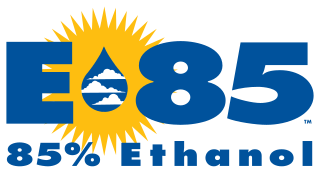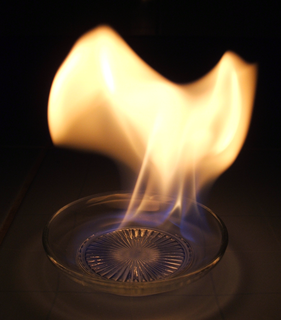
In chemistry, an alcohol is any organic compound in which the hydroxyl functional group (–OH) is bound to a carbon. The term alcohol originally referred to the primary alcohol ethanol, which is used as a drug and is the main alcohol present in alcoholic beverages. An important class of alcohols, of which methanol and ethanol are the simplest members, includes all compounds for which the general formula is CnH2n+1OH. It is these simple monoalcohols that are the subject of this article.
Ethanol is a chemical compound, a simple alcohol with the chemical formula C
2H
6O. Its formula can be also written as CH
3−CH
2−OH or C
2H
5−OH, and is often abbreviated as EtOH. Ethanol is a volatile, flammable, colorless liquid with a slight characteristic odor. It is a psychoactive substance and is the principal type of alcohol found in alcoholic drinks.
Methanol, also known as methyl alcohol among others, is a chemical with the formula CH3OH (a methyl group linked to a hydroxyl group, often abbreviated MeOH). Methanol acquired the name wood alcohol because it was once produced chiefly by the destructive distillation of wood. Today, methanol is mainly produced industrially by hydrogenation of carbon monoxide.
Butanol (also called butyl alcohol) is a four-carbon alcohol with a formula of C4H9OH, which occurs in five isomeric structures (four structural isomers), from a straight-chain primary alcohol to a branched-chain tertiary alcohol; all are a butyl or isobutyl group linked to a hydroxyl group (sometimes represented as BuOH, n-BuOH, and i-BuOH). These are n-butanol, 2 stereoisomers of sec-butanol, isobutanol and tert-butanol. Butanol is primarily used as a solvent, as an intermediate in chemical synthesis, and as a fuel. It is sometimes also called biobutanol when produced biologically and petrobutanol when produced from petroleum, those two names refer to very same substance, but highlight the different origin.

Denatured alcohol, also called methylated spirit or denatured rectified spirit, is ethanol that has additives to make it poisonous, bad-tasting, foul-smelling, or nauseating to discourage recreational consumption. It is sometimes dyed. Pyridine, methanol, or both can be added to make denatured alcohol poisonous, and denatonium can be added to make it bitter.

The National Hot Rod Association (NHRA) is a drag racing governing body, which sets rules in drag racing and hosts events all over the United States and Canada. With over 40,000 drivers in its rosters, the NHRA claims to be the largest motorsports sanctioning body in the world.
1-Pentanol, (or n-pentanol, pentan-1-ol), is an alcohol with five carbon atoms and the molecular formula C5H11OH. 1-Pentanol is a colorless liquid with an unpleasant aroma. It is the straight-chain form of amyl alcohol, one of 8 isomers with that formula.

Ethanol fuel is ethyl alcohol, the same type of alcohol found in alcoholic beverages, used as fuel. It is most often used as a motor fuel, mainly as a biofuel additive for gasoline. The first production car running entirely on ethanol was the Fiat 147, introduced in 1978 in Brazil by Fiat. Ethanol is commonly made from biomass such as corn or sugarcane. World ethanol production for transport fuel tripled between 2000 and 2007 from 17×109 liters (4.5×109 U.S. gal; 3.7×109 imp gal) to more than 52×109 liters (1.4×1010 U.S. gal; 1.1×1010 imp gal). From 2007 to 2008, the share of ethanol in global gasoline type fuel use increased from 3.7% to 5.4%. In 2011 worldwide ethanol fuel production reached 8.46×1010 liters (2.23×1010 U.S. gal; 1.86×1010 imp gal) with the United States of America and Brazil being the top producers, accounting for 62.2% and 25% of global production, respectively. US ethanol production reached 57.54×109 liters (1.520×1010 U.S. gal; 1.266×1010 imp gal) in 2017-04.

Liquid fuels are combustible or energy-generating molecules that can be harnessed to create mechanical energy, usually producing kinetic energy; they also must take the shape of their container. It is the fumes of liquid fuels that are flammable instead of the fluid. Most liquid fuels in widespread use are derived from fossil fuels; however, there are several types, such as hydrogen fuel, ethanol, and biodiesel, which are also categorized as a liquid fuel. Many liquid fuels play a primary role in transportation and the economy.

A beverage-can stove, or pop-can stove, is a do it yourself, ultralight, alcohol-burning portable stove. The simple design is made entirely from aluminium cans, lending itself to countless variations.

A breathalyzer or breathalyser is a device for estimating blood alcohol content (BAC) from a breath sample. Breathalyzer is the brand name for the instrument that tests the alcohol level developed by inventor Robert Frank Borkenstein. It was registered as a trademark on May 13, 1954, but many people use the term to refer to any generic device for estimating blood alcohol content.

Top Alcohol refers to two different classes in professional drag racing: Top Alcohol Dragster and the Top Alcohol Funny Car. Commonly known as "alky" cars, both are akin in design to the premier Top Fuel classes, but less powerful. In Top Alcohol Dragster, the cars used supercharged ("blown") engines, burning alcohol (methanol). Top Alcohol Funny Cars look similar to Fuel Funny Cars, with about half the power of a Top Fuel car. In this class only alcohol cars with three-speed transmissions are allowed.

E85 is an abbreviation typically referring to an ethanol fuel blend of 85% ethanol fuel and 15% gasoline or other hydrocarbon by volume.
Oxygenated chemical compounds contain oxygen as a part of their chemical structure. The term usually refers to oxygenated fuels. Oxygenates are usually employed as gasoline additives to reduce carbon monoxide and soot that is created during the burning of the fuel. Compounds related to soot, like polyaromatic hydrocarbons (PAHs) and nitrated PAHs, are reduced also.

Alcohols have been used as a fuel. The first four aliphatic alcohols are of interest as fuels because they can be synthesized chemically or biologically, and they have characteristics which allow them to be used in internal combustion engines. The general chemical formula for alcohol fuel is CnH2n+1OH.
In automobile and aircraft engineering a fuel gauge or gas gauge is an instrument used to indicate the amount of fuel in a fuel tank.

n-Butanol or n-butyl alcohol or normal butanol is a primary alcohol with a 4-carbon structure and the chemical formula C4H9OH. Its isomers include isobutanol, 2-butanol, and tert-butanol. Butanol is one of the group of "fusel alcohols" (from the German for "bad liquor"), which have more than two carbon atoms and have significant solubility in water.

The bioconversion of biomass to mixed alcohol fuels can be accomplished using the MixAlco process. Through bioconversion of biomass to a mixed alcohol fuel, more energy from the biomass will end up as liquid fuels than in converting biomass to ethanol by yeast fermentation.
Second-generation biofuels, also known as advanced biofuels, are fuels that can be manufactured from various types of non-food biomass. Biomass in this context means plant materials and animal waste used especially as a source of fuel.
Isopropyl alcohol (IUPAC name propan-2-ol; commonly called isopropanol or 2-propanol) is a compound with the chemical formula CH3CHOHCH3. It is a colorless, flammable chemical compound with a strong odor. As an isopropyl group linked to a hydroxyl group, it is the simplest example of a secondary alcohol, where the alcohol carbon atom is attached to two other carbon atoms. It is a structural isomer of 1-propanol and ethyl methyl ether.












